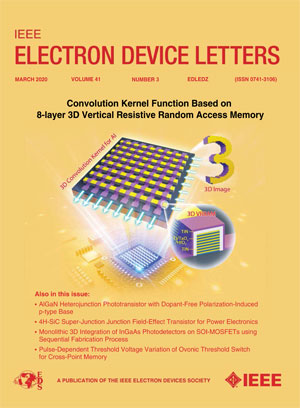Extremely Thin Proximity Platinum Silicide Formation Process Using Continuous-Wave Laser Scanning Anneal
IF 4.1
2区 工程技术
Q2 ENGINEERING, ELECTRICAL & ELECTRONIC
引用次数: 0
Abstract
Series resistance reduction becomes a very difficult challenge for extremely scaled MOSFETs. Proximity silicidation has been widely investigated to form a thin silicide as close to the gate edge as possible, but inherent nonuniformity of the silicide thickness was the limiting factor for practical application. In this work, a novel silicidation process primarily heats the metal layer first using a continuous-wave laser scanning anneal to confine the silicidation process only to the interface of the silicon substrate and the metal layer. As a result, a 2-nm-thick layer of platinum silicide was formed. The resistivity of platinum silicide was使用连续波激光扫描退火技术的极薄近邻硅化铂形成工艺
降低串联电阻对于超大规模的 MOSFET 来说是一项非常艰巨的挑战。为了在尽可能靠近栅极边缘的地方形成薄的硅化物,近距离硅化工艺已被广泛研究,但硅化物厚度固有的不均匀性是实际应用的限制因素。在这项工作中,一种新型硅化工艺主要是利用连续波激光扫描退火技术先加热金属层,从而将硅化过程限制在硅衬底和金属层的界面上。因此,形成了 2 纳米厚的硅化铂层。硅化铂的电阻率为52.5~\mu \Omega \cdot $ cm,与快速热退火工艺得到的结果相似。使用连续波激光扫描退火工艺将有可能实现真正的近距离硅化。
本文章由计算机程序翻译,如有差异,请以英文原文为准。
求助全文
约1分钟内获得全文
求助全文
来源期刊

IEEE Electron Device Letters
工程技术-工程:电子与电气
CiteScore
8.20
自引率
10.20%
发文量
551
审稿时长
1.4 months
期刊介绍:
IEEE Electron Device Letters publishes original and significant contributions relating to the theory, modeling, design, performance and reliability of electron and ion integrated circuit devices and interconnects, involving insulators, metals, organic materials, micro-plasmas, semiconductors, quantum-effect structures, vacuum devices, and emerging materials with applications in bioelectronics, biomedical electronics, computation, communications, displays, microelectromechanics, imaging, micro-actuators, nanoelectronics, optoelectronics, photovoltaics, power ICs and micro-sensors.
 求助内容:
求助内容: 应助结果提醒方式:
应助结果提醒方式:


